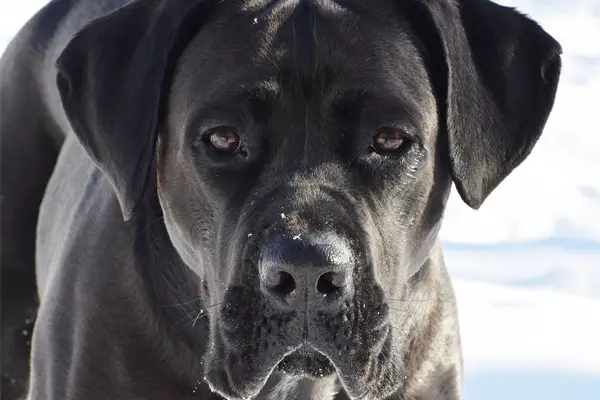The Mastiff is an ancient breed, and if you can describe them in one word, you’ll be using the word “Massive.” With a height that reaches 30 inches the least, this dog can tackle down a full-grown man. Scary right? Well, don’t be.
Though they are built with sturdy and muscled bodies, Mastiffs are known as good-natured dogs. They are gentle giants, as others would call them. They feature a massive head with wrinkled foreheads, giving an alert expression.
As family dogs, they are very loving, loyal, and protective. But, if you want to have them as pets, there are several factors that need to be considered, such as your living space.

Mastiff Statistics
| Dog Breed Group | Working Group |
| Height | 30 inches & up (male); 27.5 inches & up (female) |
| Weight | 160-230 pounds (male); 120-170 pounds (female) |
| Lifespan | 6-10 years |
Mastiff Ratings
| Energy level | |
| Exercise needs | |
| Requires attention | |
| Playfulness | |
| Trainability | |
| Shedding | |
| Grooming | |
| Friendly with family | |
| Friendly with strangers | |
| Friendly with other dogs | |
| Prey Drive |
Mastiff History
The Mastiff’s origin was way back centuries ago. They are believed to be descendants of the ancient dog breed, Molosser. And historical evidence suggests that Mastiff-like dogs have served as guard dogs, war dogs, and entertainment dogs for millennia.
The Mastiffs we know of today were developed in England. They were used as big-game hunters, guard dogs, and war dogs. They even fought alongside the British against the French in 1415. They were excellent working dogs. Sadly, the breed almost came into extinction twice.
The first one was after the year 1835. It was when bloody sports such as bull baiting, bear baiting, and dogfighting were no longer allowed.
They only came back in during the 19th century when dog shows started to rise. This was also the time when the calmer versions of the breed came out. However, when the two world wars broke, their numbers started to decline again.
Food was scarce, and since the Mastiff ate a lot because of their large size, it was impossible to feed them. Fortunately, two Mastiff puppies were brought to Canada after World War II. These two puppies became the foundation to recover the breed.
However, as to when and how the Mastiff came to the US is still unclear. But what is sure, though, is that the American Kennel Club finally registered the breed in the year 1885.
Until now, the Mastiff remains one of the most popular dog breeds in the US as a “gentle giant.”

Mastiff Temperament
Far from their war dog history, Mastiffs are calm and quiet. The American Kennel Club describes them as courageous, dignified, and good-natured. They are never shy, and they are not vicious, either.
He is loving and affectionate when it comes to family. And since he is a very calm dog, he is a great companion for older children. Just keep him away from toddlers (especially the Mastiff is an adult) to avoid accidents and injuries because of their massive size.
When the need arises, the protective nature of Mastiffs also comes out. They don’t like conflict, so you can expect them to step up when he sees someone in the family arguing. Even though they appear tough, this dog breed is highly sensitive and must be treated with care.
With strangers, Mastiffs are polite. However, you can expect him to stay alert in case you might need him. They make excellent watchdogs and guard dogs. They’ll likely corner thieves until someone arrives to catch them.
If you have other pets growing with your Mastiff, then this is not a problem either. They are very peaceful with other animals, but same-sex aggression might come out in a few Mastiffs.
The key to maintaining a Mastiff’s calm temperament is early and frequent socialization and training. Just remember to be patient with them. You should also stay consistent and let him know that you’re his leader.
Another thing to note is that this can be a messy breed. They are gassy dogs, and they snore, drool, and slobber. They are not an excellent fit for everyone. Plus, they need ample space to stretch their big body. So, an apartment building environment will not do well with them.
Mastiff Care Requirements
- Nutrition: Although a large-sized dog, it is still essential not to overfeed a Mastiff. All you need to remember is to give them a high-quality and well-balanced diet that will provide him with the nutrients he needs for his massive body. The amount of food he eats will depend on his age, size, and activity level. Naturally, the more active the Mastiff is, the more food is required. It’s best to consult a vet to guide you on his daily calorie intake if you find a hard time calculating it. It also doesn’t matter if you feed him commercial dry food or a home-cooked meal. But do take note that high-quality ingredients are a must. Stay away from dog food containing meat by-products, plant-based protein, or fillers as these don’t have enough nutrients for your dog’s needs. For home-cooked meals, make sure it contains the right amount of protein, carbohydrates, fats, and fiber. You can ask your vet as to where you can get these nutrients.
- Grooming: Mastiffs have a short, dense coat that sheds at least once or twice a year. It needs very minimal grooming. Most of the time, all you need to do is give it a quick brush every few days. You can also create a schedule like doing it weekly to remove any loose hair and this reducing it when shedding season comes. Bathing them can also be done occasionally. However, the wrinkles, especially the deep ones, should be cleaned regularly to avoid skin infection. Pay attention to the ears as well. And since Mastiffs are prone to drooling, make sure to keep a cloth in handy and be ready to wipe off some drool from time to time. Check and trim the nails too so your Mastiff is comfortable when he’s walking or running.
- Exercise: Mastiffs don’t require a lot of exercise. As a matter of fact, they do well as indoor dogs. However, just to keep them healthy, you should give them at least 30 minutes of exercise daily. This is most of the time in the form of walks. You can’t take Mastiffs for jogging because of their large size. They quickly feel hot and easily get tired too. So, make sure to bring lots of water when taking him for daily walks, especially if the weather is hot.
- Health: Sadly, these good-natured dogs have a very short lifespan. This is why it’s necessary to keep his health at optimum as much as possible. Mastiffs are prone to bone cancer osteosarcoma and lymphosarcoma. This is also their usual cause of death. Unfortunately, screening tests are not available, so you can find out if your dog has it. But, since it’s genetically transferred, you can always check with the parents. Another primary health concern is bloating. It’s when the stomach twists and prevents the dog from burping, which causes a cut off in blood supply. Heart diseases are also serious concerns. Other common health conditions to watch out for are eye diseases, hip and elbow dysplasia, allergies, and epilepsy. Regular check-ups will help in detecting certain medical conditions early. If screening tests are available, it’s best to have your dog take it.
- Lifespan: The life expectancy of Mastiffs is 6-10 years.

Famous Mastiffs
- Hercules, Zorba, and Cloe: Earned a Guinness Book of World Record for being the largest living dog
- Tank: A YouTube sensation star with over three million views
- Barady: The first Mastiff registered under the American Kennel Club
Fun Facts About Mastiffs
- They are believed to have descended from the ancient Alaunt and Molosser dogs.
- The name Mastiff came from an Anglo-Saxon word, which means powerful.
- There are multiple types of Mastiffs – Argentinian Mastiff, Brazilian Mastiff, Bullmastiff, English Mastiff, French Mastiff, German Mastiff,
- Italian Mastiff, Neopolitan Mastiff, Pyrenean Mastiff, Spanish Mastiff, and Tibetan Mastiff.
- They have a very short life expectancy.
- They mature slowly.
- They come in three colors: fawn, apricot, and brindle.
- They almost went extinct in the early 20th century.
The post Mastiff appeared first on Furry Friends Gear.

No comments:
Post a Comment